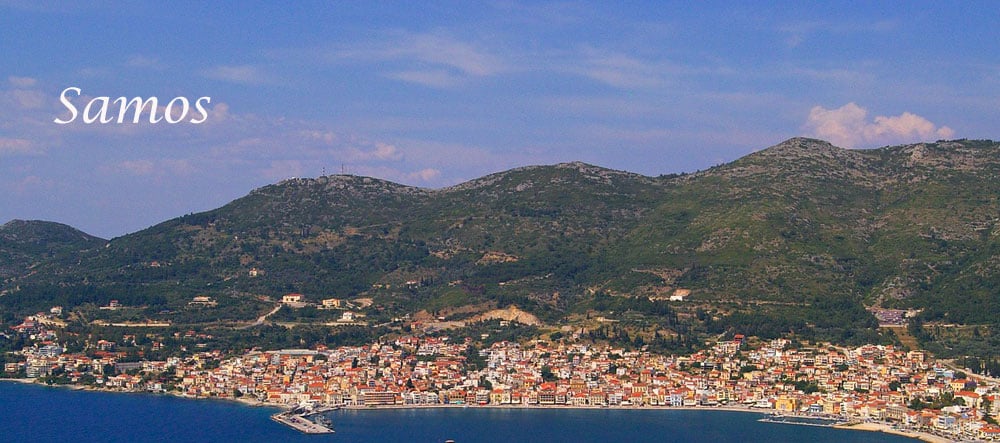Information about Samos island
Samos is one of the most beautiful islands of Greece in the east Aegean, it is a green island covered with pine forests, wonderful beaches, traditional villages and many archaeological sites.
The island is situated north of the Dodecanese islands and in recent years has become a popular holiday destination. .
Samos is also the island of Pythagoras one of the most famous mathematicians of the Greek antiquity.
It is a fairly large island, and the people on the island live off tourism and agriculture, mainly olives and fruit. The local wine is well known and worth a try. The ouzo also from Samos is one of the best in Greece. Samos is famous as well for its shipbuilding of Greek fishing boats the kaikia or trehantiria.
Most holidaymakers stay in Pythagorion (which was the ancient capital of the island) or Kokkari one of the most picturesque villages of the island, 10 km from Vathy on the north side of Samos. The resort is ideal for wind surfing and has very nice beaches. Both places have many shops, restaurants and bars but they have still not been over commercialised. The latter is considered a very good spot for surfing since it is situated at the windy north coast.
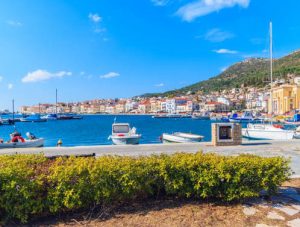
The town is divided to the new town of the ano Vathy and the old town with many places to stay, restaurants and accommodations.
Because of its past, Samos has many places of interest, and it is a very good idea to rent a vehicle and explore the island on your own.
Samos is mostly a mountainous island of the north east Aegean. The capital of the island is Samos or Vathy with has 5575 inhabitants. The island is very near to Turkey, with narrow channel, the Strait of Samos, that separates Samos from the coast of Turkey. The island has many natural beauties and is very green.
Its coast line has many wonderful beaches surrounded by pine forests. To the east is the island of Ikaria only a few miles away to the south are the islands of Agathonisi, Patmos and Lipsi and to the north are the islands of Chios and Lesvos. Before taking its final name, the island was called Anthemia (flower blossom) because of its natural beauty.
The island has three large bays, the Vathi bay, Marathokambos bay and Tigani and many capes.The coast of Samos has a total length of about 159 km The island has an area of 472.48 square km and its territory is mountainous with high mountains like Kerkis with steep slopes and ravines and Ampelos with highest peak the Prophet Elias (1060 m).Lower branches of these two mountains is Kokrou Dere, the thick mountain, Bairaktari, Mpournias etc.
Samos has no rivers, but there are plenty of water, streams, rivers and streams. There are 3 geothermal water sources with small ferrous quantity. Samos is the manufacturing centre of the prefecture.The island has a significant wine industry and many companies that producing Ouzo.There is also several manufacturing companies that processing agricultural products. The island main export is wine and especially the sweet white Samiotiko wine as well as tobacco. The best time to visit Samos is in Spring and late summer.
On this green island at the edge of the Aegean between pine forests and olive groves, in lands with citrus fruits and fertile vineyards, you will discover myths and historical truths.
Samos, with Vathi as its capital and with over 30,000 inhabitants, has three ports which are also the main settlements, such as Vathi in the northeast, Karlovasi in the northwest and Pythagoreio in the southeast.
The island of Samos is full of wonderful beaches, impressive sights and archaeological monuments. It is an ideal destination for a relaxing holiday and offers the opportunity for a variety of activities such as nature walks, climbing and hiking.
Stroll through the traditional settlement of Samos, which is built amphitheatrically on the hillside, with its narrow streets, countless two-story houses with tiled roofs. The city of Samos stretches along the sea and together with Vathi now form a single city with a long history.
Visit the ruins of the Polykrateian Wall, the Ancient Theater and the Roman Baths, the Eupalinian trench and of course the famous Heraion. Here, according to tradition, the goddess Hera was born and raised. It is considered one of the largest temples of the time that had the right to grant asylum.
You should definitely visit the Cave of Pythagoras – at the foot of Mount Kerketea – which, according to legend, is where the philosopher Pythagoras fled to hide from the pursuit of the Tyrant Polycrates. There is another version of the story, according to which Pythagoras used the cave as a hermitage, to ponder philosophical questions without distraction. 320 steps lead to the entrance of the Cave, with a spectacular view.
Enjoy the beauties of the island by visiting the Biotope of Alyki, the Genoese castle in Potami, the Archaeological Sites of Thermae and the Pythagorean Castle, the Archaeological Museum of Samos, the Pythagorean Museum, Panagia Sarandaskaliotissa, the Monastery of Megali Panagia and many other historical monuments.
Discover the beaches with sand or pebbles, organized or more isolated and with crystal clear waters. Enjoy your swim at the small windless Psili Ammos beach, in Mykali, Livadaki, Balos, Mikro and Megalo Seitani and others such as Tsamadou, Potami, Tsabou.
It is worth getting to know the picturesque villages, built on green slopes. The massif of Kerketea and the area from Potami to Mikro and Megalo Seitani form a huge natural “park”, an ideal vacation spot for those who love nature and hiking.
Samos produces excellent quality local products, such as olive oil, citrus fruits and the famous Sami wine. Taste recipes such as Kampounia, Bourekia, Yaprakia, Keskeki, Xerotigana, Mustalevria, Katades, Tahinopita and Starozumo.
History
Samos is historically a very interesting place. It was an important island during ancient times since it was a rich island that traded with the rest of Greece, the Phoenicians and Persians.
According to mythology, the goddess Hera was born here, and there are still ruins of her temple to be seen, the Heraion.
It was also an intellectual center with various famous people living and working there. One of ancient Greece’s best known scientists, Pythagoras, was from this island, but Aristarchus, Epicurus, Herodotus and Aesop also lived here. The island flourished economically and culturally during the 6th and 5th century, but had a drawback when it tried to revolt against Athens in 440 BC to which it was forced to pay yearly tributes.
Later on, Samos was to be a Roman province, and during Byzantine years the island kept its prosperity. When the Turks invaded in the 15th century, Samos lost its freedom and was uninhabited for a century. The island was not to be Greek again until 1931, even though the Greek revolution had started in 1821.
Geography
Samos belongs to the east Aegean islands complex about 1 mile from the coast of Turkey. It is a green island with idyllic bays and sandy but also rocky beaches. The vegetation reaches all the way to the sea. It has an area of 477 square kilometers, a length of 45 kilometers and a width of 19 kilometers, while its coastline is 141 kilometers long.
The smaller part of the island is lowland in the south of the island, while the larger part consists of two mountains, the rocky and wild Kerkis in the west (1443 meters high) and the green Ambelos or Karvounis in the east (1160 meters high). In Kerki we find many caves, some dedicated to Christianity and others a monument to the glorious antiquity of the island. More important than these are the cave of Kakoperatos, the cave of Pythagoras, the cave of Panagia tis Makrini, the cave of Kandili, the cave of Sarandaskaliotissa and the Hole of Panaretos.
Climate
Summer in Samos can be very hot, with temperatures reaching 31-34 °C in June and a bit higher in July and August. But these high temperatures are usually compensated by the beautiful sunshine that lasts for 14 hours every day, from
Samos in autumn has a more relaxed and cooler climate. The temperature is moderate and makes hiking and more demanding activities enjoyable. The average October temperature remains around 20 °C, while at night around 18 °C
The winter months in Samos are known for their heavy rainfall, with several rainy days during the months of December, January and February. Sunshine is limited to 5 hours a day and maximum temperatures hardly reach 15°C.
Economy and products
The development of Samos was mainly based on the cultivation of the land and especially on viticulture, olive cultivation and tobacco cultivation. The subsistence needs of the inhabitants were also covered by livestock and fishing.
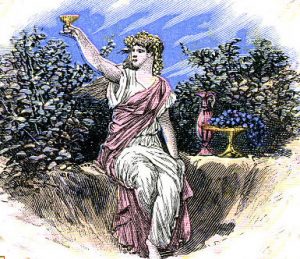
Tobacco cultivation developed mainly at the end of the 19th century and the beginning of the 20th, where the production of good quality tobacco favored the development of trade and the establishment of tobacco factories. Sami cigarettes became known all over the world. Around the same time, tanning also developed on the island.
Large tanneries are established in Vathi and especially in Karlovasi, where the space favors their operation. The island prospered and large mansions, industries and warehouses were built, many of which are preserved to this day and reflect the prosperity of that era.
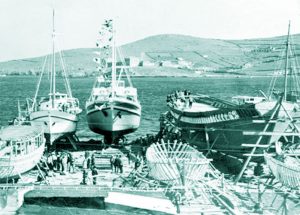
The Samian “trachea pine” was in demand and supplied the shipyards of all Greece with timber, while it was also the raw material for the construction of the local ships. Today, there are very few dockyards left, where mainly fishing “trehanterias” are built or repaired.
Pottery also developed on the island. The good quality soil it possessed was suitable for the manufacture of vases. In workshops, mainly in the villages of Mavratzaioi, Koumaradaioi, Myloi, Karlovasi and Manolates, beautiful ceramics are made in traditional and modern forms. A characteristic vessel is the so-called “Just Cup” with which, according to tradition, Pythagoras taught equal treatment. Inside it has a grooved line as a limit, which if one exceeds, the mug is completely emptied.
The development of traditional folk art in micro-craftsmanship and silversmithing, is marked alongside the economic boom of Samos. Elaborate gold and silver jewelry that was created is exhibited in historical collections, such as the one housed in the Ecclesiastical Byzantine Museum of Samos. Furthermore, there is intense artistic activity related to metalwork, decoration, wood and stone sculpture, whose outstanding works are found mainly in old mansions and public buildings.
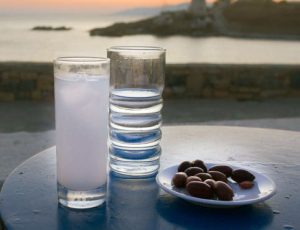
The orchid has been cultivated since 1980 in various varieties, with exports all over the world.
Other local products are handlooms, green soap, dairy products (cheese and yogurt), trachanas, spoon sweets and jams, fish and seafood. Honey, with distinct flavors, texture and rich aromas, due to the variety of aromatic plants and trees. Pollen, propolis and royal jelly are also produced.
Tourist development
Tourism in Samos began to develop in the 1960s, mainly in the areas of Pythagorio, Kokkario and Agios Konstantinos. Towards the end of the 1980s it spread throughout the island, with an emphasis on coastal areas. Today, there are remarkable accommodations and the quality of the services provided is constantly being upgraded and follows modern trends and standards.
Villages
Vathy
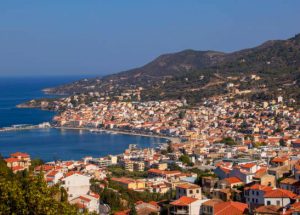
There is also a painting exhibition and an archaeological museum with many artefacts from the excavation of the temple to Hera , as well as a Byzantine museum with exhibits from the religious and byzantine past of the island.
The town is actually divided into the old and the new capital. The old capital, Ano Vathy, is built on a hilltop. Every summertime, in the early evening, the long promenade of Vathy is buzzing with people taking a stroll and stopping at the numerous restaurants and cafeterias which line the seafront.
The town of Vathy has some impressive neo-classical buildings. The town hall has an art gallery which exhibits paintings of the famous Greek artist, Nikiphoros Litras. There is also an interesting archaeological museum which displays findings from the excavation of the village of Heraion. The Byzantine museum is another place worth seeing with its fascinating exhibits from the Byzantine era. Close to Vathy are some wonderful beaches.
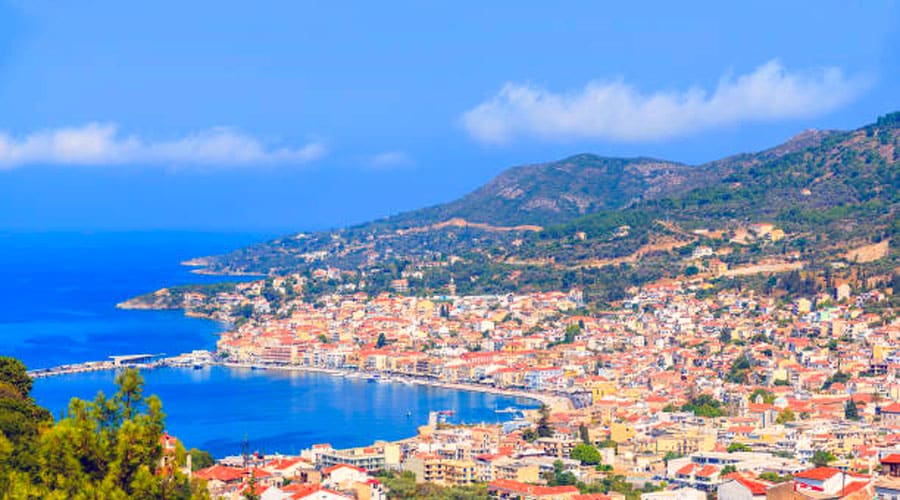
Pythagorion
Pythagorion is the third largest village, and is in itself worth visiting. Here, there is a small archaeological museum, as well as some interesting churches. There is also a Venetian citadel here, and a little further away you can visit the monastery of Panagia Spiliani (The Virgin Mary of the Cave). Ancient ruins of the old town can be seen here, as well as the water tunnel/pipe of Eupalinus from the 6th century BC.
You can also visit the ruins of the Hera temple, Heraion. What you see today dates back to the 6th century BC, but the first temple built to her honour here was actually constructed in the 13th century BC and was made of wood.
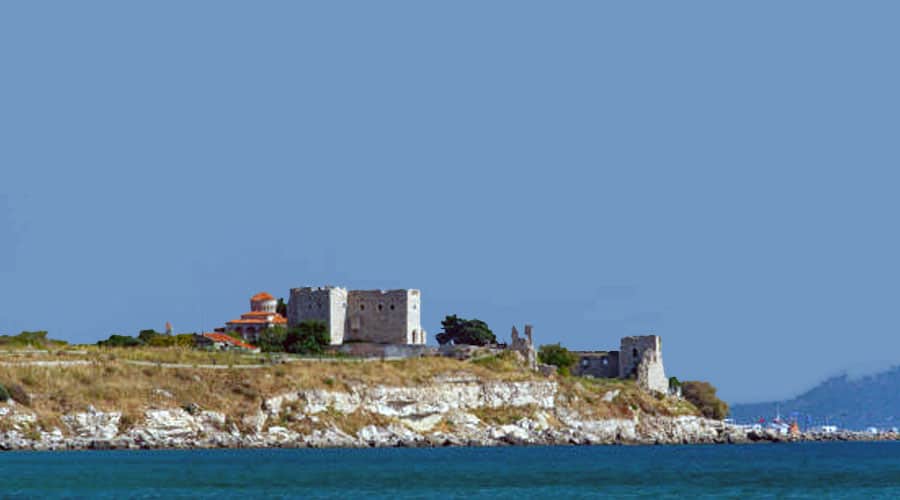
Marathokambos
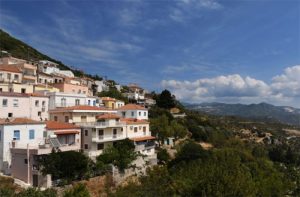
Close to this lies another cave where a small church is secreted inside. In Kakoperato is another interesting cave with its fascinating formations of stalactites and stalagmites. This cave is located close to the beach of Votsalakia on the west side of Marothokampos. In the area there is the interesting Monastery of St. John, which can be reached by boat from Ormos.
Above the village of Kalithea there is another cave that has a small, old church dedicated to the Virgin Mary, inside are some beautiful frescoes. Another interesting village to visit is the village of Mitilinioi, where Mitilinioi village stands today, the ancient city Hissia was.
It is a place of great paleontologic interest and many fossils have been found here of animals which existed some million years ago. Samples of the fossils can be seen today in the Paleontological Museum of the area. Among them you can see fossils of dwarf elephants, a prehistorical lions, giraffes, rhinoceros and a horses.
Karlovasi
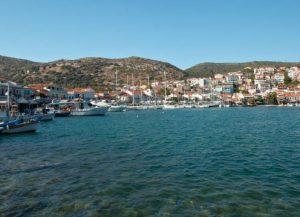
These include the building which today is the School of Mathematics, and the buildings which now house the primary school and the Magistrates Court.
Nearby Kalovassi there are ruins of a Byzantine fortress and adjacent to this is a church which dates from the 11th century AD. In the village of Kondokaika is the interesting monastery of St Hellias that dates from the 17th century AD and has wonderful Byzantine frescoes
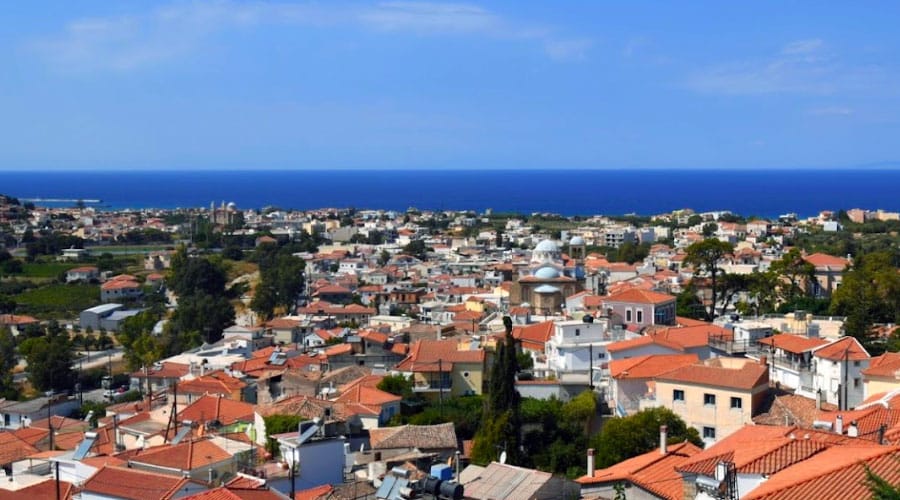
Chora
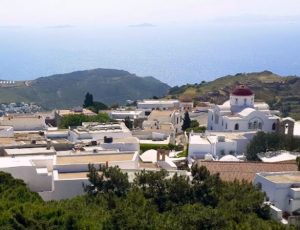
It is worth visiting the church of Agia Paraskevi, but also going up to the chapel of the prophet Elias, in the northern part, where the village ossuary is. From here you will enjoy a magnificent view towards the plain of Chora and the airport, Potokaki, Pythagorion, the Heratis gulf as well as the archaic sanctuary of the goddess Hera, called Kolona because of the unique column of the ancient temple that is still preserved in its place .
Chora was built after the reconcentration of the population of Samos, in the late 16th and early 17th centuries, and was the capital of the island for over 250 years.Visit the church of Saint Demetrius, the oldest parish church of Samos, while for swimming you will go to the beaches of Potokaki and Poros.
In Chora you will find a few rooms for rent, traditional cafes and picturesque taverns, which are ideal for lovers of peace and seclusion.
A big festival with local songs and dances takes place on the fifteenth of August, the feast of the Virgin Mary, and on July 26, the feast of Saint Paraskevi.
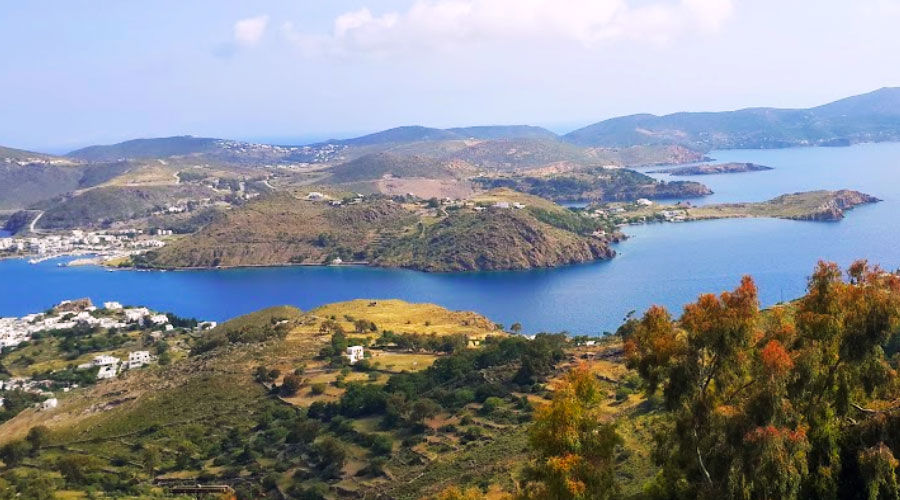
Avlakia
Avlakia is a seaside settlement, 14 kilometers from the city of Samos. Avlakia is located between the secular Kokkari and the village of Vourliotes and has an amazing sandy beach, which is a magnet for visitors to the island. Avlakia beach consists of three small scattered beaches within the settlement, with calm waters protected by the headland to the north of the village.
The area belongs to the developing tourist resorts, while next to Avlakia, there are the three most famous, cosmopolitan beaches of the island, Tsabou, Tsamadou and Lemonakia. Near the settlement of Avlakia there are some mountainous, very picturesque traditional villages, which you can visit.
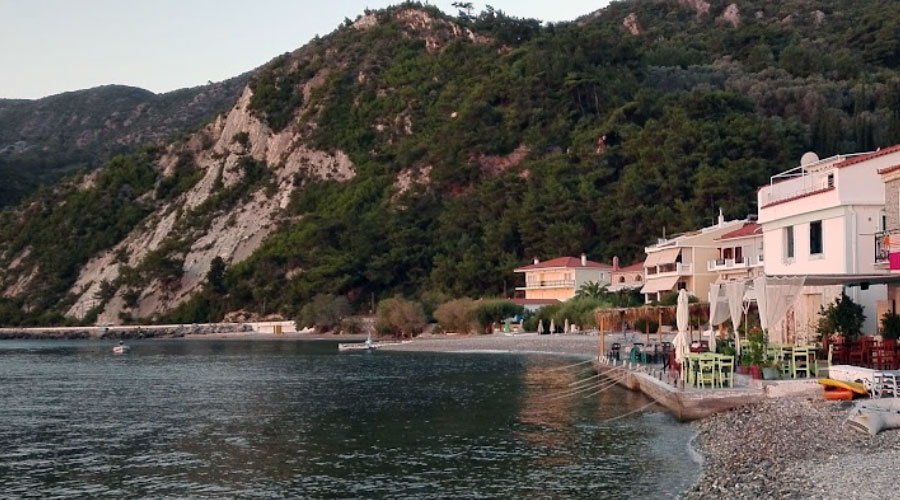
Samiopoula
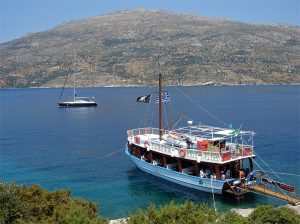
The main beach of the island, Psalida, is a sheltered bay with fine, white sand and calm sea, which is often filled with visitors. It only has a few umbrellas and… nothing else. Sailboats and small boats usually anchor in the small bay of Katsaka which protects from the prevailing north-westerly winds.
The few buildings on the island include the chapels of Agia Pelagia and the Ascension of the Savior, a small tavern, accommodation and warehouses. The island has an electrical and telephone connection with Samos through underwater pipelines.
Photovoltaic systems provide additional electricity. Tanks (cisterns) are maintained on the island for the collection and maintenance of rainwater. The subsoil is mostly rocky and the trees are few, but there is a rich wild vegetation of shrubs, holly and wildflowers. The wild goats greatly outnumber the few residents as well as the summer visitors in the summer.
During the summer season, the island is connected by daily ferry routes from the ports of Pythagoreion and Marathokampos.
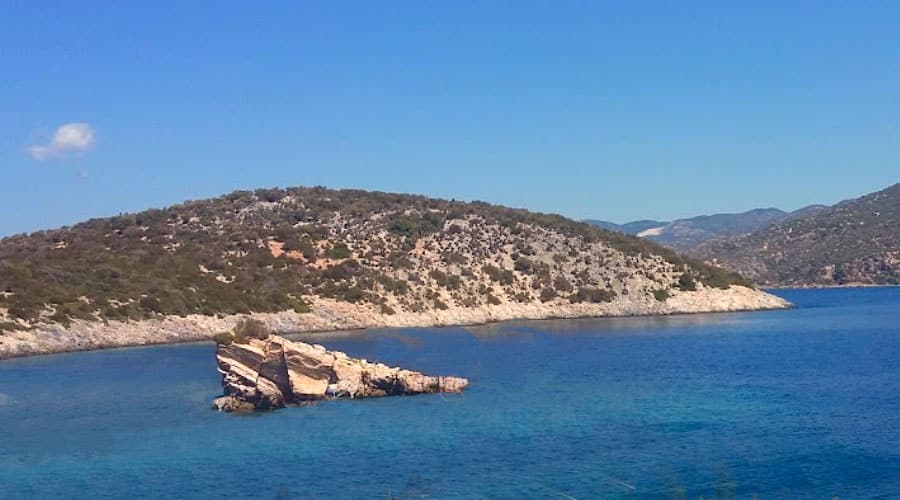
Kokkari
Kokkari located ca. 10 km from the town of Samos and is supported by tourism, which is also the main occupation of the permanent residents. Kokkari was built at the beginning of the 19th century and is said to derive its name from the extensive cultivation of kokkari,a type of small onion.Kokkari was built at the beginning of the 19th century as the port of Mytilinioi village.
There is not much to do in Kokkari, but you will love everything you do. In addition to walking along the main street of the village – which is beautiful – you can enjoy your coffee, drink or food there. Of course, at the end of the road there is the beautiful double beach that remains unforgettable to anyone who visits it.
The attraction in Kokkari is the well-preserved old houses, the small port and the beaches that surround it. One of the important attractions of Kokkario is the church of Agios Nikolaos, while a great festival is held on July 27, the feast of Agios Panteleimon.
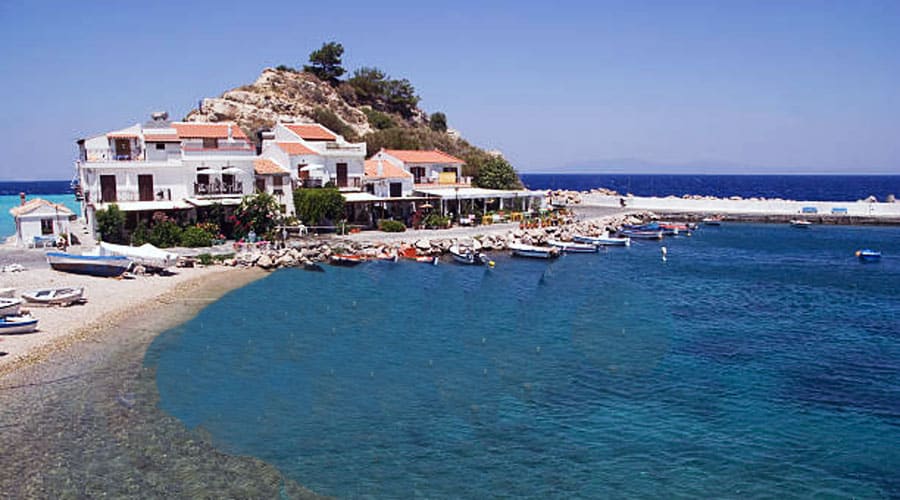
Vourliotes
The village of Vourliotes is built in a privileged location. It is surrounded by dense vegetation, vineyards and has an amazing view towards the sea. It is located 18 km northwest of the capital. It got its name from its first inhabitants, who came to the island from the Vourla of Asia Minor.
Among the attractions of the area, it is worth visiting the Castle of Lazarus. These are the remains of a medieval settlement and castle as well as the Castle of Loulouda, the ruins of which are located 3 km from the village.
In the village of Vourliotes is also the historic monastery of Panagia Vrontiani which was founded in the 15th century and has a rare collection of Byzantine icons.
At a distance of 2 km from the village is the famous Spring of Pnakas. An enchanting location with dense vegetation and abundant running water. From Vourliotes you can reach the beaches of Avlaki, Kampos and Tsabou.
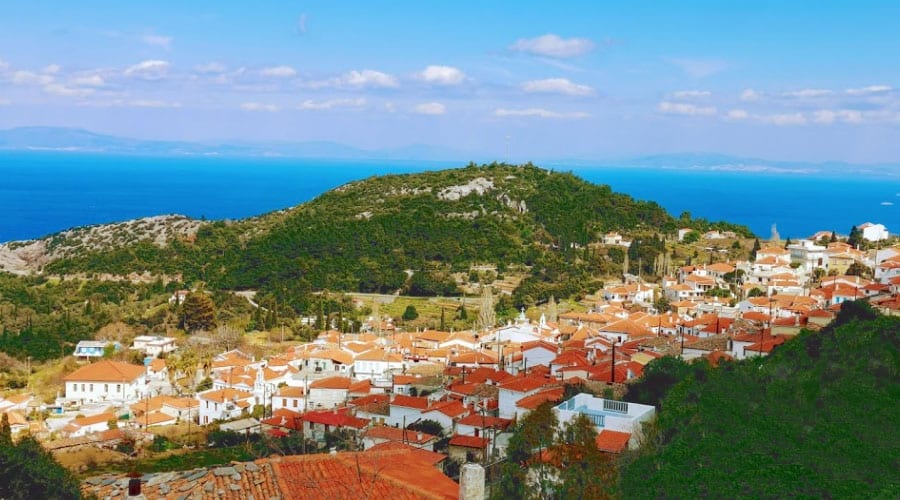
Agios Konstantinos
Agios Konstantinos is a seaside village located 20 km northwest of Vathy, on the road to Karlovasi.It is built in an idyllic location, drowned in greenery. It consists of two small settlements, Ano Agios Konstantinos, where there is also the homonymous church from which the area takes its name, and Kato Agios Konstantinos, founded in the 19th century.
In Agios Konstantinos you will mainly see holiday homes and hotels of all categories. It is worth visiting the area and admiring its natural beauties. It consists of the coastal Agios Konstantinos (formerly known as Ormos Agios Konstantinos) and the current Ano Agios Konstantinos.
How and when Agios Konstantinos was created is not known precisely. It seems that towards the end of the 18th century it originated, together with other settlements, from the spread of the inhabitants of Vourliotes.
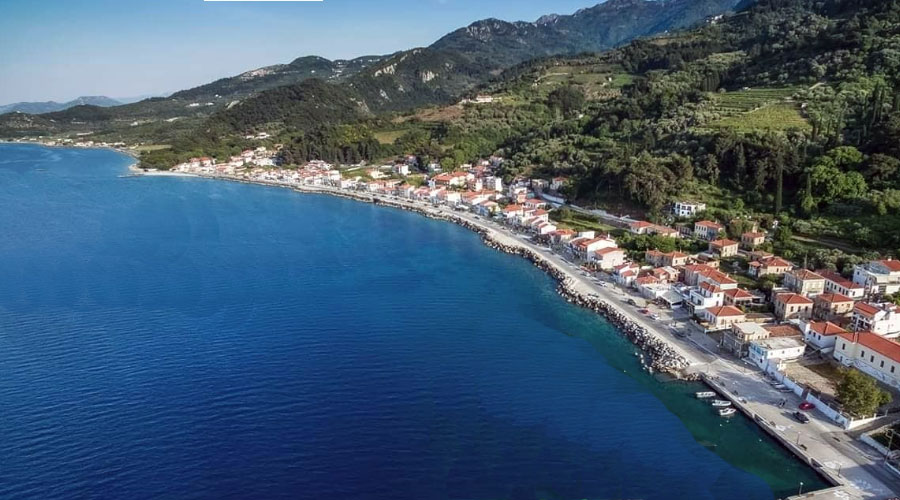
Pyrgos
Pyrgos is one of the largest villages of Samos, located in the center of the island, at the foot of Mount Ampelos, near the river Amfilisos, in a green landscape with many running waters. It is 16 kilometers from Pythagorion and 30 kilometers from the town of Samos and is a focal point to the mountain villages of the island.
The history of the village begins in 1715 when the first inhabitants who came from Pyrgos Diros of Laconian Mani fled there to avoid the Turkish yoke. They were the ones who gave their new settlement the name of their village and built a church dedicated to Saint George who was one of the beloved saints of their homeland. There is also a second version which claims that the first settlers came from Pyrgos Ilias.
Pyrgos was a settlement with great economic growth thanks to the rich agricultural production of honey, wine, oil and also black pine wood. At the same time, its position in the center of the island had made it a service point for the surrounding villages.
The village has narrow cobbled streets, traditionally built houses, old churches and old water mills. In the square of the Tower stands the unfinished stone church of Agios Georgios, which has historical value for the locals, while a monument to fallen soldiers of the Second World War has been erected.
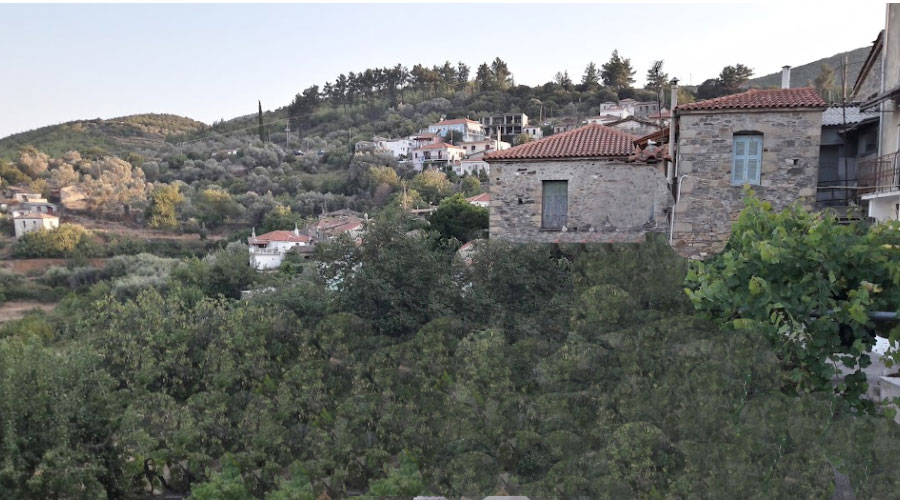
What to do
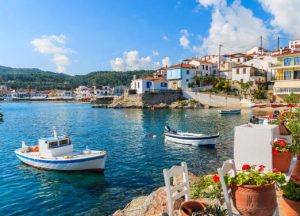
There is a daily hydrofoil that connects the island with the Dodecanese islands of Patmos, Lipsi, Leros,Kalymnos and Kos ,so you can make a day trip to one of those islands.
There are several festivals on Samos. The most interesting is the festival held on Vathi which celebrates the unification of Samos with the rest of Greece on the 11th of November. On the 20th August is the festival which celebrates St. Hellias.
This festival is held at Karlovasi where you can enjoy a special dish made from meat and wheat, called giorti. This is given to everyone free of charge. As everywhere in Greece, the Assumption of the Virgin Mary on 15th August is a special day in Samos. In June there is the Fisherman’s Festival in Pithagorio. On 6th August is the commemoration of the Battle of Mycale, held in Portokaki.
What to see
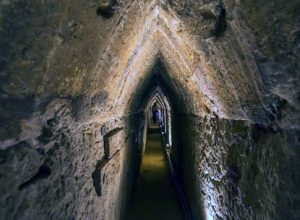
The primary purpose of the tunnel was to serve as an aqueduct, bringing fresh water from a spring on the northern side of Mount Kastro to the ancient city of Samos (now Pythagorion). The aqueduct ensured a steady supply of water to the city, especially during sieges.
The tunnel was commissioned by the tyrant Polycrates and was constructed in the 6th century BC. Eupalinos of Megara was the engineer behind the design and execution.
Archaeological Museum of Samos
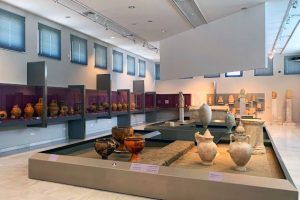
The museum houses collections of archaic sculpture, as well as ceramics, copper and wooden objects from various periods. The museum’s most important exhibit is the 5.5-meter kouros
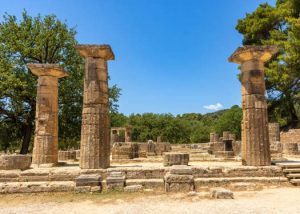
Local customs and tradition
Tradition is a living part of the island’s social life. A separate custom is the preparation of the so-called “celebration”, which is cooked overnight in huge cauldrons on the eve of religious holidays and is offered after the divine service. The basic raw material is wheat with onions and goat. A variant is “keskeki”, where the wheat is not ground, but is used pounded.
At Halloween, in many villages, the custom of Kadi is revived, which satirizes current events through performances from another era. At Easter in Marathokambos, the custom of the “Ovids” is preserved. At the beginning of spring, “Sanidogla”, a large open-air swing for young men and women, is revived. On June 23, in Ai Giannis of Klidonas, big fires are lit and young people jump over the flames.
The outdoor festivals are also numerous and well attended, with live music, dancing, food and plenty of Samian wine. They are mainly inspired by local customs and traditional products, such as the “Pancake Festival” in Mytilene and Platanos, the “Orange Festival” in Mylos, the “Onion Festival” in Koumeika, the “Souma Festival” in Kastania, Pandrossos and many mountain villages, the “Kyvelomagiremata” in Pyrgos, the “Festival of Mustalevria” in the Mediterranean, etc.
Cultural Events
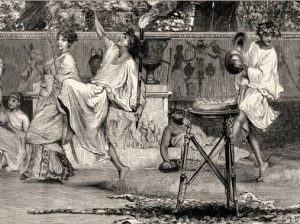
The Samos Wine Festivals are organized every summer by the Municipality of Samos, all over the island, with a multitude of musical and dancing events and protagonists. At the celebration, free Sami wine is distributed to all attendees, along with local delicacies and traditional tastes.
Visual art exhibitions (painting, photography, film/video, installations), presented by artists and groups of creators who draw inspiration from interesting local and global themes.
The Heraia with references to the ancient mysteries related to the worship of the goddess Hera. They are held under the auspices of the Hellenic National Committee for UNESCO and the Hellenic Olympians Association. Philosophical, scientific conferences and high-level artistic events are held during them. Its point of reference is the representation of the ancient festival of the Heraeans that took place in Samos 2400 years ago.
The Ireon Music Festival is one of the most popular in the Eastern Aegean. It takes place at the beginning of August, in Heraion of Samos. It started in 2004 and every year hosts well-known artists of the Greek and foreign music scene and at the same time gives the opportunity to local amateur groups to present their work.
Film Festival, organized every summer with outdoor screenings of Greek and foreign films and documentaries. The Festival of Young Artists is a unique meeting of distinguished artists from all over the world, in the ancient theater of Pythagoras, with an emphasis on cultural exchange through music. The Festival lasts 7 days, has 7 concerts and they all take place in the ancient theater of Pythagoras of Samos.
Beaches
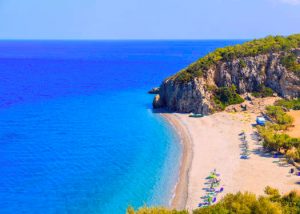
For families it is better to go to the beaches Psili Ammos ot Potokaki. Samos’s beaches are either pebble or sand ones.
Although not a beach, the waterfalls near Karlovassi are wonderful for swimming.Samos has plenty of beaches all around its coast line. Here you will find some of the best beaches in the north east Aegean. The beaches of Samos are mainly pebble and sand. Many of them are well organised and accessible by car, buses or bikes. On the organised beaches you will find umbrellas, sun beds, beach bars and taverns or restaurants.
Near and around Vathy the capital of Samos are the beaches of Mykali with pebbles very long and well organised with water sports facilities and restaurants.
The beach of Psili Ammos is a sandy beach not so long but with nice sand and shallow waters. Another beach in Vathy is Poseidonio beach accessible by cat or scooter, pebbles and organise with umbrellas and a restaurant.
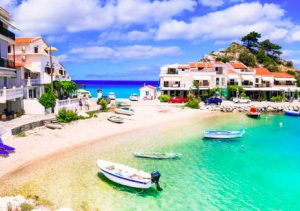
Near to Kokkari located probably the best beach of Samos the Tsamadou beach that you can see on every tourist liflet about Samos. Its surrounded by green landscape with crystal blue waters and white pebbles.
You can get there by car but you have to walk about 180 meters to get to the beach. Very near to Tsamadou is Lemonakia beach another wonderful beach of Samos with pebbles and well organised.
The beach of Kokkari is ideal for windsurfing with many facilities, cafes, restaurants and umbrellas and has become a meeting point mainly for German surfers but is getting rough with the meltemi.
Nightlife
Samos boasts a lively nightlife that caters to a variety of preferences. The island’s main town, Vathi (also known as Samos Town), is a hub for nightlife activities. You can find a range of bars, pubs, and clubs that stay open until the early hours of the morning. These venues often feature live music, DJ sets, and dancing, creating an energetic atmosphere for both locals and tourists to enjoy. Many bars are situated along the waterfront, providing stunning views of the sea while you socialize and unwind.
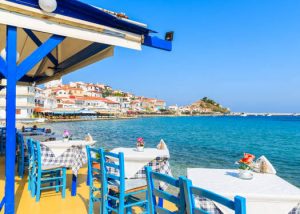
Samos is known for its beautiful beaches, and some of these beaches come alive at night with beach bars and parties. Beach bars often host events, including live music, beach parties, and themed nights. These gatherings provide a unique opportunity to enjoy the island’s stunning coastal landscapes while having a good time with fellow travelers.
Where to stay
Samos offers a diverse range of accommodations that cater to different tastes, preferences, and budgets. From the traditional white-washed Greek villas perched on hilltops to modern luxury resorts overlooking the sea, the island has something for everyone.
The quaint towns of Pythagoreio, Vathy, and Kokkari are home to charming bed and breakfasts, boutique hotels, and local guesthouses that exude an authentic Grecian ambiance. These establishments often offer a more intimate experience, allowing guests to immerse themselves in the local culture, traditions, and flavors of Samos.
For those seeking a more opulent experience, Samos boasts a selection of upscale hotels and resorts equipped with world-class amenities, spa services, and gourmet dining. These properties often provide panoramic sea views, private beaches, and infinity pools, making them perfect for travelers looking for a slice of paradise.
Budget travelers and backpackers are not left out, as the island also provides a plethora of affordable accommodations. From hostels to self-catering apartments, Samos ensures that everyone can enjoy its beauty without breaking the bank. Additionally, many of these affordable options are located in prime areas, ensuring that the island’s attractions are within easy reach.
Camping enthusiasts will be delighted to discover that Samos has a few well-maintained camping sites. These are often located close to the beach, offering a unique opportunity to sleep under the stars, lulled by the gentle sounds of the Aegean waves.
Shopping
Shopping in Samos Island offers a mix of traditional products, local crafts, and modern shopping options. Whether you’re interested in exploring bustling markets, discovering local art, or finding unique souvenirs, Samos provides a diverse shopping experience that complements its overall charm and allure.
The local wine and Ouzo is a nice souvenir to enjoy during cold winter nights at home. Samos also produces a lot of ceramics, but also religious items like icons are good buys. The island also has quite a lot of art and antiques, as well as clothes, leatherwear and jewellery. Samos also has a special kind of rugs which are called Flokati.
For everyday essentials and practical shopping, the island has supermarkets and convenience stores scattered throughout its towns and villages. These stores provide a convenient option for purchasing groceries, toiletries, and other necessities during your stay.
Getting around
Moving around in Samos is relatively easy and offers a variety of transportation options to explore its stunning landscapes, charming towns, and cultural attractionsApart from the possibilities or rent a car or a bike, you can also get around fairly easy with the local buses. There are also boats that can take you to some of the beaches, as well as the little island Samiopoula.
Samos offers a range of transportation options to suit different preferences and travel styles. Whether you prefer the flexibility of renting a vehicle, the convenience of public transportation, or the guidance of guided tours, you’ll find ways to navigate the island and make the most of your stay.
Getting to Samos
Samos during he summer has a lot of charter connections with many west European countries. Many tourists choose to fly to Samos and from there to visit some of the near by Dodecanese islands like Patmos and Leros by hydrofoils. The journey is about one to one and a half hour. Samos has its own airport. If you are travelling on your own you can also take from Athens a ferry boat from Piraeus, there are about five a week, during high season daily.
By Air
Most international travelers will first fly to Athens, the capital of Greece. Athens is well-connected to major cities around the world. Once you arrive in Athens, you have several options to reach Samos:
From Athens, you can take a domestic flight to Samos International Airport (SMI). The flight duration is approximately 50 minutes, making it the quickest way to reach the island.
Alternatively, you can take a domestic flight from Athens to the nearby island of Mykonos, and then take a ferry from Mykonos to Samos. This option allows you to combine air and sea travel and enjoy scenic ferry rides between the islands.
Ferries to Samos
Samos has several ferry connections to other Greek islands and mainland ports. You can take a ferry from ports like Piraeus (Athens), Kusadasi (Turkey), and other nearby islands. Ferry schedules can vary based on the season, so it’s recommended to check the available routes and timings in advance.
Ferries depart from Piraeus (the main port of Athens) and arrive at the port of Vathi in Samos. The journey duration depends on the type of ferry, ranging from around 8 to 12 hours.
If you’re traveling from Turkey, you can take a ferry from Kusadasi to Samos. This route offers a convenient way to reach the island. Samos is also connected to other nearby islands like Ikaria, Chios, and Mytilene, providing opportunities for island hopping.
Travel information
Flight and ferry schedules can vary based on the season. It’s recommended to plan your travel during the high tourist season (spring to early fall) when transportation options are more frequent and reliable.
Especially during peak tourist months, it’s advisable to book your flights and ferry tickets in advance to secure your preferred travel dates and times..
Keep in mind that weather conditions, especially in the winter, can occasionally affect ferry schedules. It’s a good idea to check for any travel advisories or updates before your departure.
Facts about Samos
| Capital: Samos | Usefful telephones |
| Size: 470 sq. km | Emergency 100 |
| Population: about 32.642 | Samos Hospital: +30 22730-83100 |
| Highest Mountain:Kerkis 1440mt | Police Department:. +30 22730-87315 |
| Airport: Samos Airport (SMI) | Fire Department +30 22730-22199 |
| Banks and Cash machine: Yes | Samos Hospital +30 22730-83100 |
| University: Aegean University | Roadside assistance +30 22730-27104 |
| Hospital: Yes | Samos Port Authority +30 22730-27890 |
| Mobile coverage : 3, 4 and 5 G | Tourist Information +30 22730-28582 |
| Mobile networks: Cosmote, Nova, Vodaphone | Taxi +30 22730-28404 |
